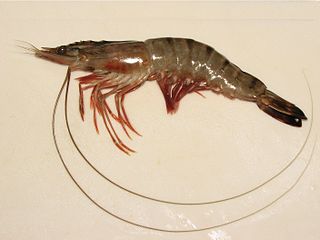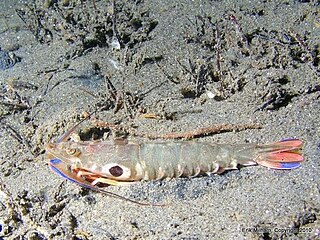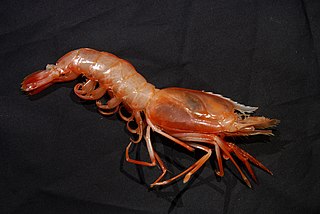
Dendrobranchiata is a suborder of decapods, commonly known as prawns. There are 540 extant species in seven families, and a fossil record extending back to the Devonian. They differ from related animals, such as Caridea and Stenopodidea, by the branching form of the gills and by the fact that they do not brood their eggs, but release them directly into the water. They may reach a length of over 330 millimetres (13 in) and a mass of 450 grams (1.0 lb), and are widely fished and farmed for human consumption.

Hippolytidae is a family of cleaner shrimp, also known as broken-back shrimp or anemone shrimp. The term "broken-back shrimp" also applies to the genus Hippolyte in particular and "cleaner shrimp" is sometimes applied exclusively to Lysmata amboinensis.

Penaeidae is a family of marine crustaceans in the suborder Dendrobranchiata, which are often referred to as penaeid shrimp or penaeid prawns. The Penaeidae contain many species of economic importance, such as the tiger prawn, whiteleg shrimp, Atlantic white shrimp, and Indian prawn. Many prawns are the subject of commercial fishery, and farming, both in marine settings, and in freshwater farms. Lateral line–like sense organs on the antennae have been reported in some species of Penaeidae. At 210 metres per second (760 km/h), the myelinated giant interneurons of pelagic penaeid shrimp have the world record for impulse conduction speed in any animal.
Farfantepenaeus notialis is a species of marine crustacean in the family Penaeidae.

Metapenaeopsis, the velvet shrimps, is a prawn genus in the family Penaeidae. It contains these species:

Sicyonia is a genus of prawns, placed in its own family, Sicyoniidae. It differs from other prawns in that the last three pairs of its pleopods are uniramous, rather than biramous as seen in all other prawns.

Litopenaeus is a genus of prawns, formerly included in the genus Penaeus. It contains five species:

Marsupenaeus is a monotypic genus of prawn. It contains a single species, Marsupenaeus japonicus, known as the kuruma shrimp, kuruma prawn, or Japanese tiger prawn. It occurs naturally in bays and seas of the Indo-West Pacific, but has also reached the Mediterranean Sea as a Lessepsian migrant. It is one of the largest species of prawns, and is accordingly one of the most economically important species in the family.
Isabel Pérez Farfante was a Cuban-born carcinologist. She was the first Cuban woman to receive her Ph.D. from an Ivy League school. She returned to Cuba from the United States only to be blacklisted by Fidel Castro's government. She and her family escaped Cuba, and she became one of the world's foremost zoologists studying prawns. She discovered large populations of shrimp off the coast of Cuba and published one of the most noted books on shrimps: "Penaeoid and Sergestoid Shrimps and Prawns of the World. Keys and Diagnoses for the Families and Genera."

Farfantepenaeus aztecus is a species of marine penaeid shrimps found around the east coast of the US and Mexico. They are an important commercial species in the US. The FAO refers to them as the northern brown shrimp; other common names, used in the US, are brown shrimp, golden shrimp, red shrimp or redtail shrimp.

Aristeidae is a family of Dendrobranchiata decapod crustaceans known as deep-sea shrimps, gamba prawns or gamba shrimps. Some species are subject to commercial fisheries.

Solenocera is a genus of prawns in the family Solenoceridae. Solenocera occur from 0 to 2,067 meters deep in the ocean.

Acanthephyra is a genus of shrimp in the family Acanthephyridae, with species that live at depths from 0 to more than 5000 meters deep below the ocean surface.
Atyoida serrata is a species of freshwater shrimp of the family Atyidae and genus Atyoida. The species lives in the Vungu, Umgeni, and Mtamvuna rivers in South Africa, as well as the Langevin River on Réunion Island.

Cryptopenaeus is a genus of prawns within the family Solenoceridae.

Hadropenaeus is a genus of prawns within the family Solenoceridae. Members of this genus are found at depths up to 1280 meters.
Solenocera alfonso is a species of decapod within the family Solenoceridae. The species is found in the eastern Indian Ocean and western central Pacific Ocean near countries such as the Philippines, Indonesia, and Australia at depths of 176 to 547 meters near benthic environments. It grows to lengths of 4 to 12 centimeters.
Solenocera hextii, the deep-sea mud shrimp, is a species of decapod within the family Solenoceridae. The species is found distributed in the Gulf of Aden, Arabian Sea and in the Bay of Bengal along the coasts of Yemen, Oman, Pakistan, India and Sri Lanka at depths of 120 to 505 meters. It is usually caught by deep sea trawlers at depths of 150 to 200 meters during January to March. Males grow to 5.5 centimeters whereas females can grow up to 13.8 centimeters in length. The species spawns from November to April, with the a peak in breeding occurring in January to February.

Solenocera acuminata is a species of decapod within the family Solenoceridae. The species is distributed in and around parts of the Caribbean Sea at depths of at depths of 150 to 400 meters, with the highest biomass being at 330 to 380 meters. Females are larger than males reaching lengths of 95.2 mm. The species is being considered for deep-sea fisheries in the Caribbean region of Colombia, however more information on the species is needed for fisheries to begin targeting the species.














